Note:
The test bike was provided to me at my request by Rose Bikes. Thus, this is also advertising.I first noticed the Rose Backroad 2018 at the Silk Road Mountain Race. There it was ridden through the mountains of Kyrgyzstan for a final test before market launch. And almost simultaneously, it officially went on sale in August 2018. Rose was thus one of the first brands to not only observe the topic of gravel bikes as a trend, but also to develop a bike with the Backroad that would become one of the best-known gravel bikes, at least in this country.
Even if the Backroad is not really suitable for races like the Silk Road or Atlas Mountain Race from my point of view, the Bocholt-based company has created a gravel bike that is very versatile, copes well with terrain off the forest highway and is also suitable for the one or other Bikepacking trip.
Our Backroad feels comfortable where a classic road bike has it difficult. It offers you the necessary smoothness and safety off-road – the ideal bullet for more flexibility in terms of route selection.
Bullet hits it quite well, because the Backroad is a very fast bike, no matter what the surface. In the beginning, I first had to get used to going faster and especially in the curves. Jule from Jule Radelt has also called the Backroad a “gravel cutter”, with which you can have a lot of fun. And I can also confirm that.
And that Graveln and Bikepacking mean above all also variety, you can see in the current model range: Alone seven Backroad models in the Carbon series, six in the AL version, three in the Limited version and two eGravel models leave hardly any wish unfulfilled.

For the test, I got the new Rose Backroad with the SRAM Rival eTap AXS XPLR 1X12. Thus, the bike is equipped with the fairly new electronic Rival 1 road bike shifting from SRAM, which switches 12 gears and is comparable to the Shimano 105/(Ultegra). XPLR means that SRAM components designed specifically for graveling have been installed here: a Rival XPLR rear derailleur for a wider XPLR cassette with 10-44 and an XPLR Rival 1 Wide crank with a 40 chainring.
Geometry
Rose positions the Backroad as a bike for the long haul and endurance:
Massive comfort on the saddle and a gravel-specific frame-fork geometry offer perfect handling on road, gravel and technical terrain. Only your thirst for beer can stop you.
As far as its stack and reach values are concerned, the Rose Backroad Carbon is a comparatively sporty and aggressive gravel bike. But you can’t see that right away. The stack/reach ratio is 1.48, which suggests a sporty riding position. From a stack reach ratio of 1.55, one speaks of an upright/relaxed sitting posture, which is especially interesting for bikes for long distances.
The stack, i.e. the vertical distance between the center of the bottom bracket and the top end of the head tube, is 586mm on the Backroad Carbon. The Reach, which is the horizontal distance between the center of the bottom bracket and the top of the head tube, measures 395mm.
To understand:
- Lots of stack and little reach mean: The frame is slightly shorter and you sit more upright.
- Little stack and much reach mean: The frame is longer and you sit more stretched/athletic on the bike.
Note: My test bike had the frame size 57 with a height of 1.84m and a stride length of 80cm.
To put the Rose Backroad Carbon in comparison with other gravel bikes, I first looked at the Votec VRX.
The VRX has a little more stack (+3mm) and less reach (-11mm) in comparison, resulting in a more upright riding position.
The Backroad has a longer chainstay with 434mm than the VRX with 420mm, which gives the Backroad more smoothness (which is also noticeable).
The second comparison I make with the Canyon Grizl, which, by the way, is driven and advertised by Jenny Tough.
Interesting here is that the Grizl has more stack (+19mm) and more reach (+14mm) than the Backroad, with the same stack to reach ratio of 1.48. Both bikes are very similar and probably comparable in their geometry and riding characteristics.
I was surprised by the geo-comparison with the Cannondale Topstone, which I remember as a fairly “aggressive” gravel bike with clear crosser genes. But looking at the specs, it’s clear that the Topstone is a long-travel swayback compared to the Backroad: the stack to reach ratio here is 1.55, which means it sits quite upright. At 610mm, the Cannondale also has a whopping 24mm more stack than the Backroad.
The Topstone also has a longer “lead” (is certainly not the technically correct word for it), so the front-center distance between the bottom bracket and front wheel axle, which is with 641mm a whole 24mm longer than the Backroad. This is also reflected in the wheelbase measurement, which describes the horizontal distance between the center of the points where the front and rear tires touch the ground. This is 26mm longer on the Topstone than on the Backroad.
Finally, a comparative look at the Specialized Diverge, which enjoys a similar reputation and status as the Backroad. Again, the Backroad is the sportier choice, as the Diverge goes for the long haul with a stack of 610mm (+24mm compared to the Backroad) and a stack to reach ration of 1.56. So the Diverge is more upright.
The Rose Backroad is therefore designed in comparison to other gravel bikes rather sporty and purely according to the geo dimensions not necessarily built for long rides (Endurance). But don’t worry: With the Backroad you can very well be on the road for many days at a stretch without bending. It is a good offer for road cyclists who want to switch to a gravel bike.
If you want the Rose Backroad to be a little more comfortable, you should check out the AL version, which has a stack to reach ratio of 1:57, making it much more upright.
Frame & Fork
The Backroad is available with a carbon or aluminum frame. The AL version of the bike was developed primarily for cost point reasons, so that offers could be made at a lower price point. In addition, it also has a more upright geo. My test bike is available for 3,800 euros. The entry-level backroad AL model starts at 2,000 euros.
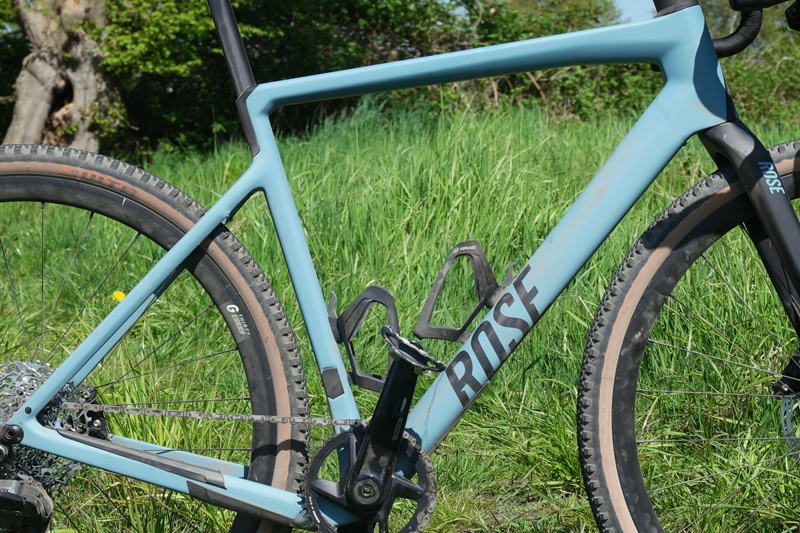
The test bike has a carbon frame and carbon fork. These are built in Asia.
The weight is worth noting: according to Rose, the frame weighs 1,020g and the fork only 425g. Thus, the finished bike comes to a weight of only 8.6kg according to Rose (8.8kg reweighed including pedals and navi holder). Unfortunately, the frame set is not available for purchase separately.
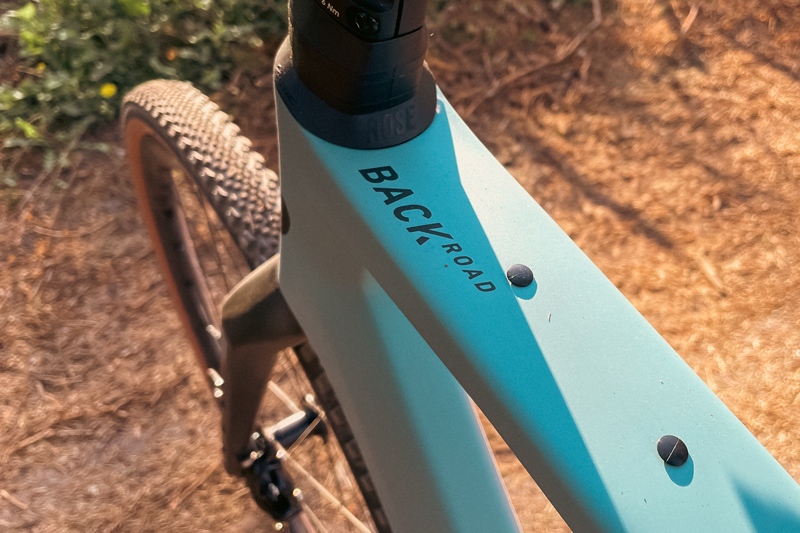
For the transport of bottles and holders, the frame offers three sets of eyelets in the frame triangle and on the down tube. In addition, another pair on the top tube, for example, to screw a cockpit bag there. The fork has three eyelets on each side and is thus prepared for anything cages or fork packs.
Nicely solved is the internal cable routing, if you like it. In any case, this tidies up the frame and handlebar area. And the D-shape called at Rose pulls through the frame design, starting with the flexing seatpost to the headset.

The Rose is also very well positioned in terms of tire clearance:
Frame and fork allow tire widths of up to 47mm at 700c and up to 50mm at 650b.
I also like the protectors on the down tube and chainstay. This is well thought out and on my off-road rides with the Backroad I have very often heard the stones and dirt bounce off the protective plastic. The extra protection on the chainstay is also very useful off-road, the chain then flips up and down from time to time and so does not bang on the carbon and the paint.
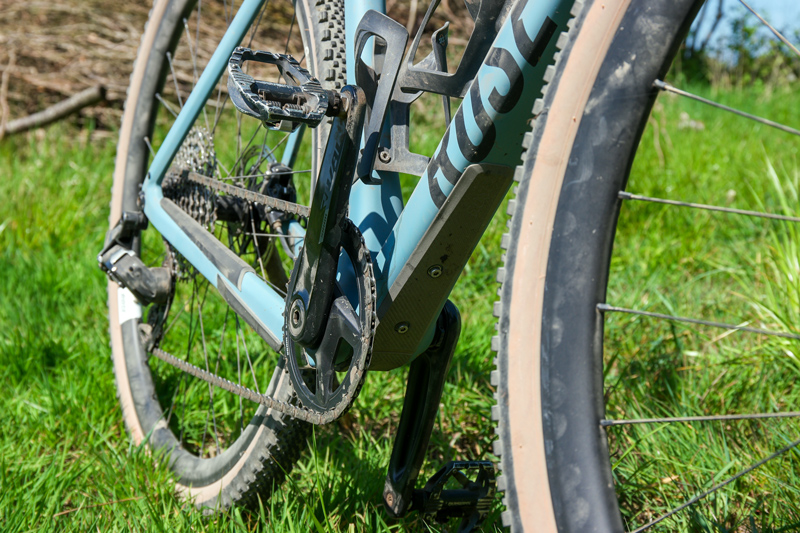
The suspension on the carbon frame is special: The delta-shaped seatpost sits in a downward pulled seat tube (covered by a strong rubber), which gives additional flex, which is quite noticeable.
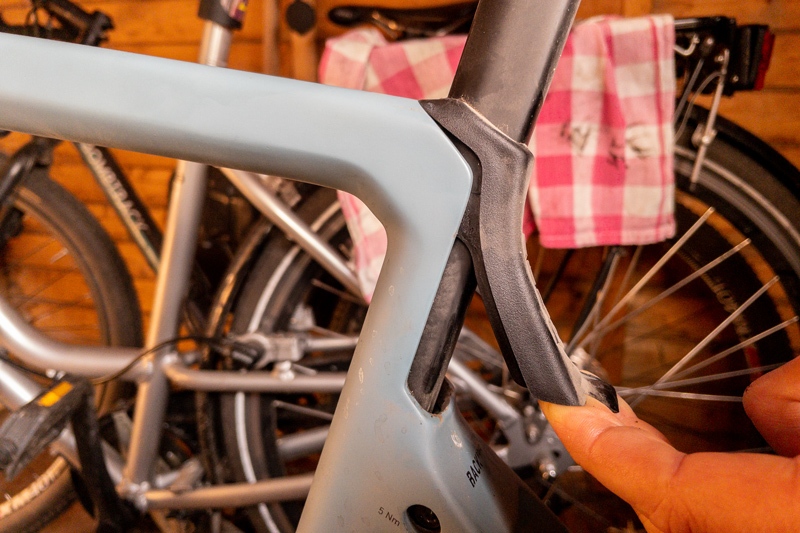
As beautifully and elegantly built as the frame and fork are, this style is also restrictive. Because by using proprietary parts, the like D-Shape seatpost or headset, you can not easily rebuild or add. A dropper post is thereby not possible with the carbon models of the Backroad and also in front one is “fixed” on the Rose stem, at least if it is to remain in the design.

In addition, carbon also has its disadvantages: Times of the current eco-balance considered, carbon seatposts are often not recommended for bikepacking saddlebags. This has mainly to do with the caution of the manufacturers, who fear unfavorable leverage or wear and thus structural damage to the carbon fibers. There are also weight restrictions on the fork to accommodate at the eyelets. Usually this is around 3kg per side. But this is often enough for people who are lightly packed anyway with the Backroad on Graveltravel tour. Even so, a carbon frame is always more sensitive and especially in rough terrain, you should therefore pay a little more attention.
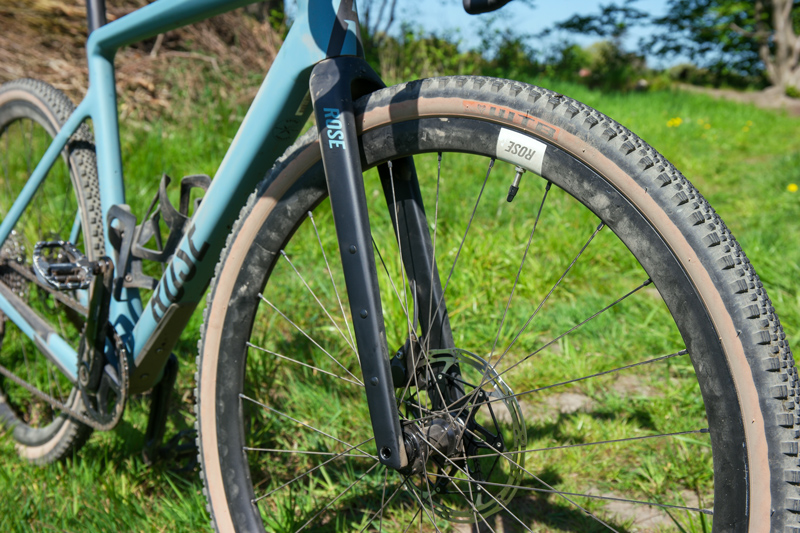
In addition, unfortunately, the system weight of the Backroad – and not only in the carbon, but also in the AL version – is limited to 110kg. This is not a problem for lighter riders who can add some luggage in addition to their body weight. I usually have 9-12kg luggage with me, plus 3 liters of water, weigh 84kg, plus the bike with just under 9kg and therefore come to 108kg. There’s no room for additional stuff, even if the system weight limit can certainly still tolerate +/-5%.
By the way, the average weight of a man in Germany is about 85kg. That of women in this country is about 71kg.
Therefore, in my view, the Rose Backroad Carbon is an ideal bike for performance-oriented graveling and Bikepacking day trips / overnight trips with light luggage. Everything else is certainly also feasible, but depends heavily on body weight and payload. In any case, the Backroad Carbon but even with luggage is a pretty agile runabout that does not back down and is incredibly fun.
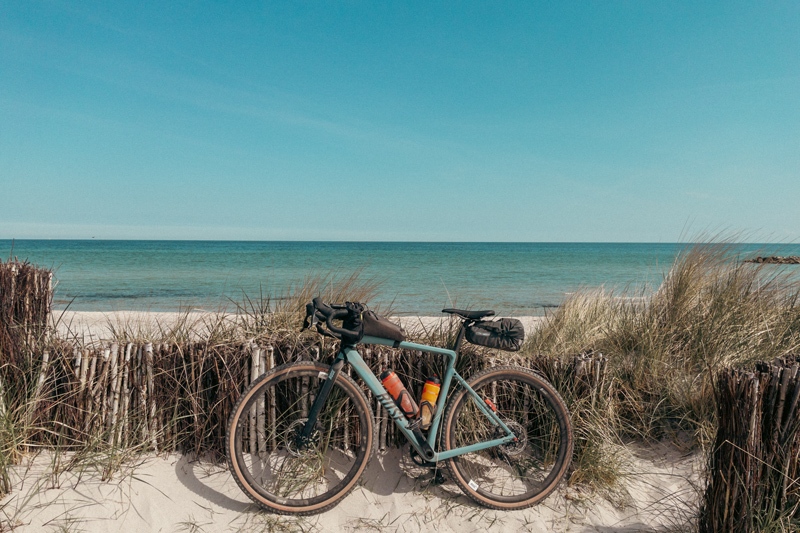
What I particularly like are the colors. They are simply modern, fresh and appropriate. The test bike came in Blue-Haze. Alternatively, the Backroad is also available in Evil Pepper Green.
The Rose Backroad comes in sizes 47, 50, 53, 55, 57, 59 and 62, which should cover quite a wide body variety, making it a good offering for both short and tall people.
Wheels and hubs
The wheels on the Rose Backroad have made a positive impression on me so far. They are quite sturdy and support a nimble ride due to the taller rim profile. The in-house 28″/700cc G-Thirty Disc Gravel rims have a medium-high profile and a 25mm inner rim width. According to Rose, they are manufactured in-house by the Bocholt-based company.
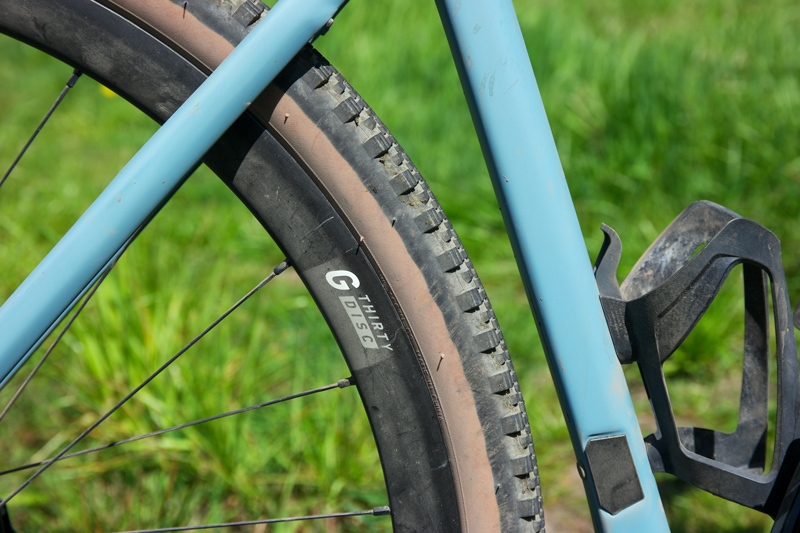
The hubs are a joint development of Rose and Newmen with 28 spokes, which have a Centerdisc brake disc mount. The wheelset costs around 450 euros (with 24 spokes), which is quite inexpensive.
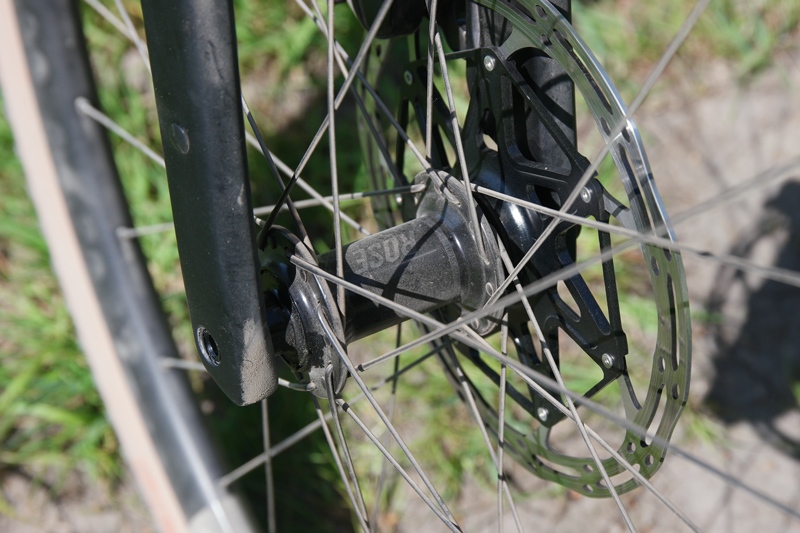
For the tires, Rose relies on the WTB Raddler. Unfortunately, they didn’t work for me at all: after only 54km, I already had two flat tires. Off-road, however, they actually work quite well and are ridden in dry conditions and appropriate pressure also safe and true to track in the curves. Nevertheless, I often had the impression that the Raddler are not up to the energy and power of the Backroad and limit the performance rather.
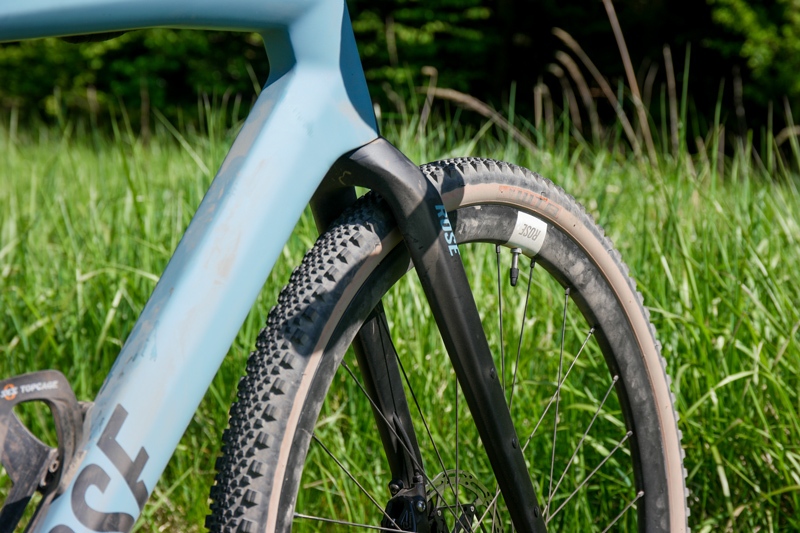
From the factory, the Backroad is delivered with tube. I would recommend you but quickly convert to tubeless. For this, however, you must install proper sealing tape, because with the wheels the rim interior is only lightly taped. And I would then change as soon as possible to other tires, such as the Schwalbe G-One Bite or R.
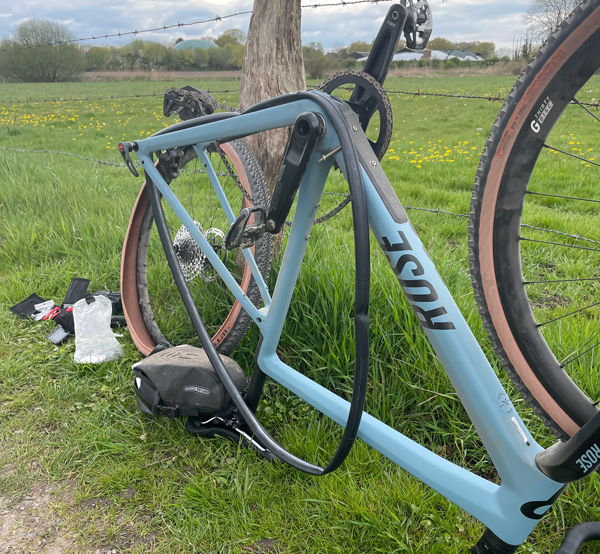
What I noticed by the flats: the rim paint layer is very sensitive. Thus, when the tire is lifted off with jacks, there are traces on the rim. In addition, stones on the rims quickly leave their mark. I do not mind, but who goes more after externals, should know that.
Gearshift & brakes
The test bike is new to the Backroad model range and has the SRAM Rival eTap AXS XPLR 1X12 installed.
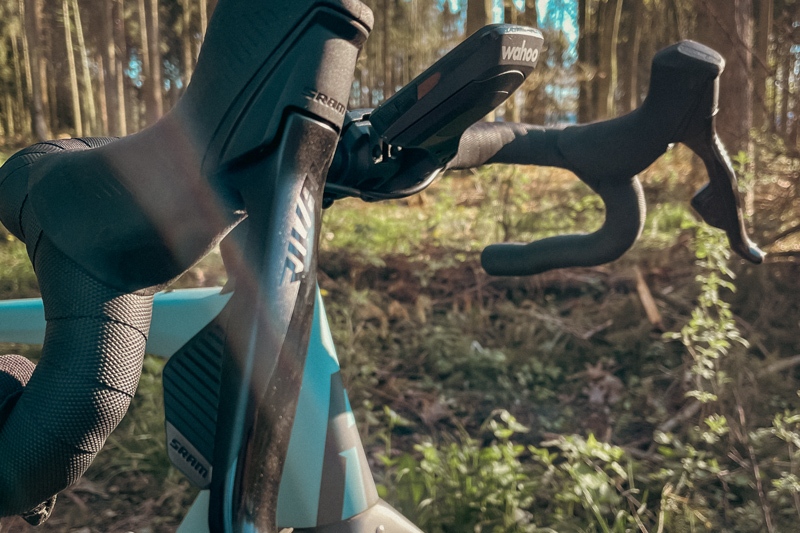
The Backroad Rival eTap AXS XPLR 1×12 embodies pure gravel action. Between new, unknown terrains and home trails you conquer with this gravel bike all paths off the road and do not stop at steep climbs.
The gearing consists of a 40 ring front and rear of a 10-44 cassette. I especially liked the fine gear graduation in the higher gears of the Rival: 10, 11, 13, 15, 17, 19, 21, 24, 28, 32, 38, 44.
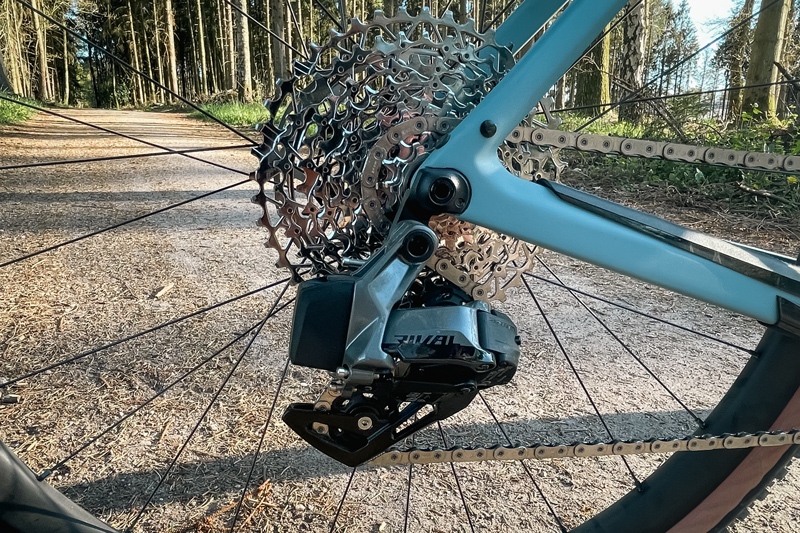
This makes it quite pleasant to react to changes and also offers enough design freedom with light luggage in the terrain and when it should get steeper. The cassette is available in two versions: once with the larger sprocket made of aluminum, once made of steel. The difference lies in the weight of 373g to 412g.

The gear ratio from 40 to 44 offers a slight reduction (great set!). This is enough without luggage or with light luggage even for climbs up to 12/13%. I’ve ridden the bike on asphalt slopes up to 15%, which went well. However, if luggage is added, it can be quite fast narrow and pushing is required. The Gravel gears are just not really designed for Bikepacking, but “only” for graveling. Some ease you can get if you change the front of 40 to a 38er sheet. Less but according to SRAM is not possible with the Rival XPLR crank.
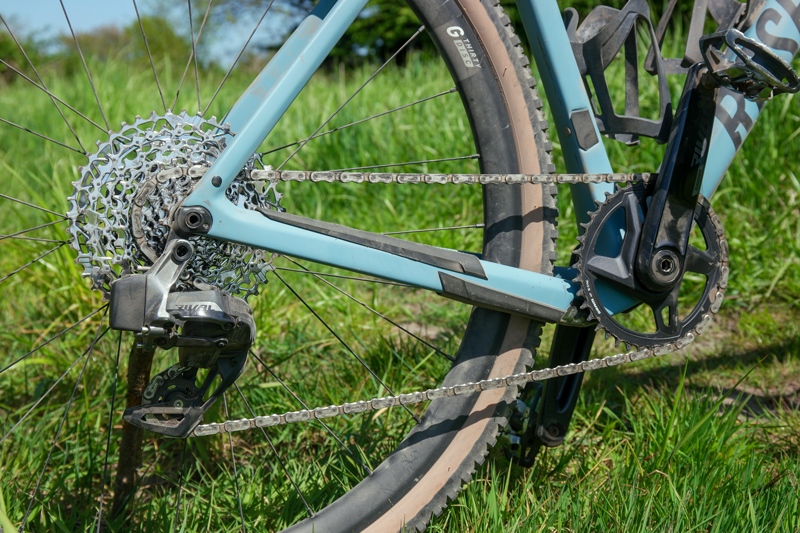
Therefore, light Bikepacking is possible. If it goes into more demanding terrain with more luggage, the end is soon there. Who would not want to do without a Backroad even under these conditions, which should look at the Classified model or the 2×11 variants with GRX.
Of course, I was curious about the performance of the new SRAM Rival AXS. As expected, it switches very precisely and reliably even under load. It’s just fun and very easy to set up and adjust. I myself have since switched to SRAM’s electronic shifting and combine a Road with a MTB circuit on my Endurance MTB.

The Rival brakes had to be braked in first, but then did a very good job. They can be dosed well and have worked well even in light wet conditions with the 160 discs. And that without grinding or squeaking.
Handlebars, Saddle & Co.
When it comes to the handlebars, Rose relies on proven quality and installs on the Rival AXS version the Ritchey Venture Max Comp in 40er width, which has this characteristic wave in the lower link.
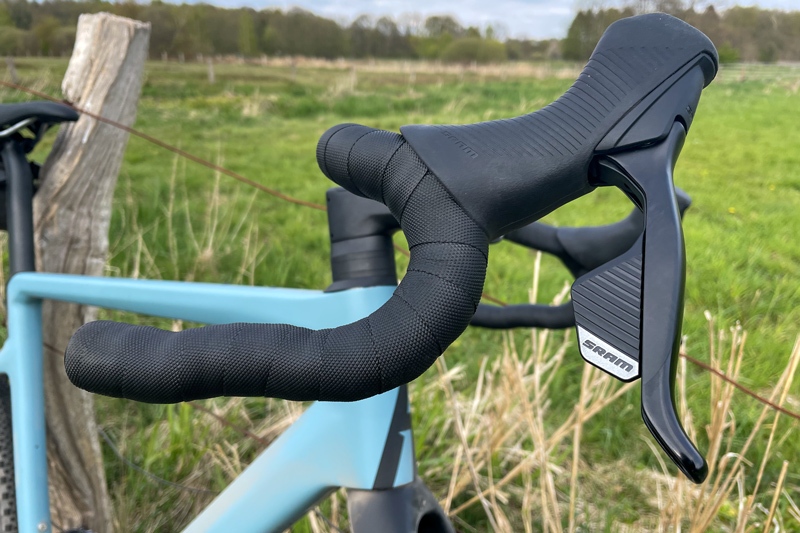
I love this wave, because the hands can “lock” there well and the bike can thus be controlled safely even off-road. Personally, I would have taken a wider handlebar, but that’s individual. Maybe you can ask Rose here in the purchase process whether the adjustment of the handlebar width is possible.
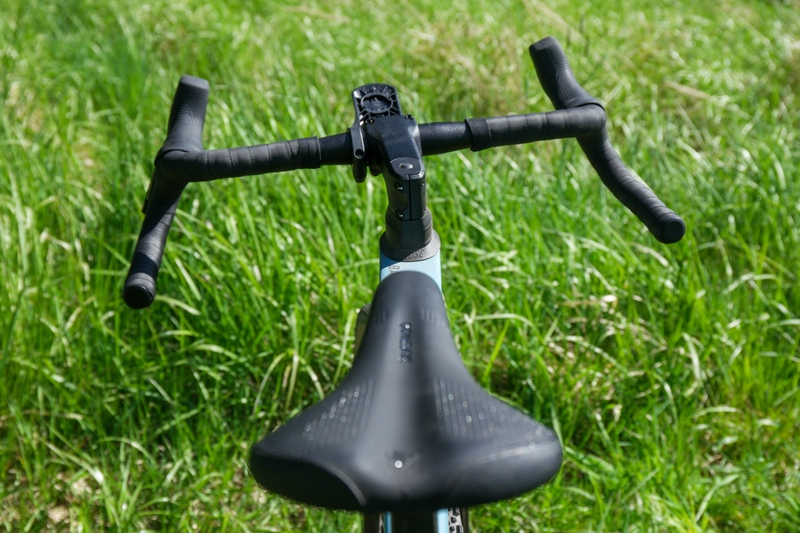
The stem is the Rose model already mentioned above, called Square, made of aluminum with 6 degrees inclination / slope. This adapts in shape to the D-shape of the headset and has front also equal openings for the installation of a GPS holder (Rose Mount Stem holder).
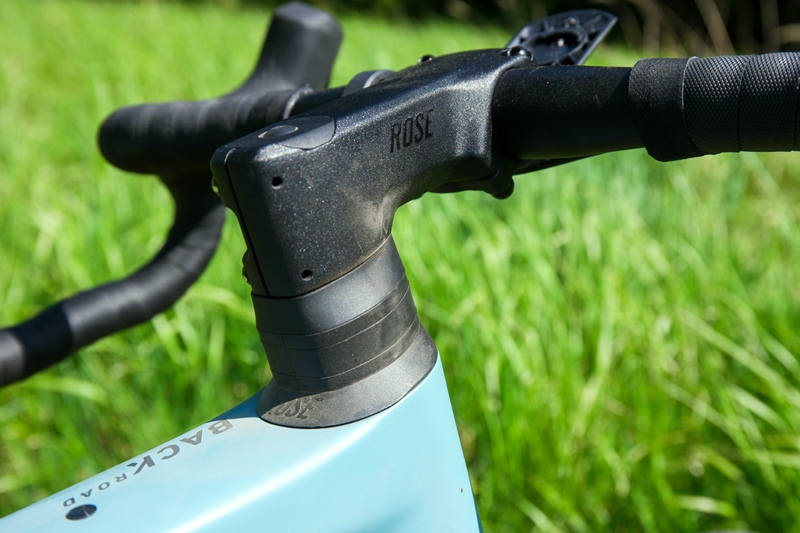
I could not find the stem on the Rose website and therefore can not say whether it is also available in other dimensions and inclinations.
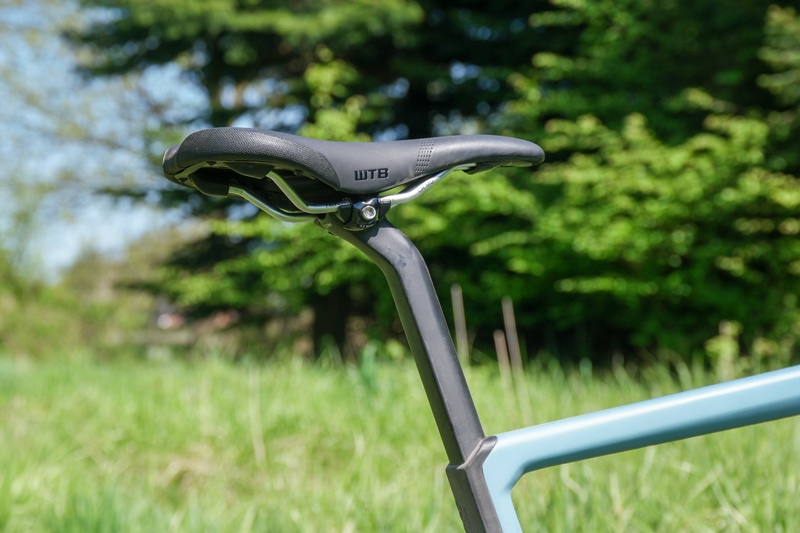
Also already thematized is the D-Shape seatpost, which is 400mm long, made of carbon and has an offset of 8mm. The seatpost is attached by the way with a clamping screw on the side of the frame. This is optically quite nicely solved. For the saddle Rose relies on the WTB Silverado. This is inconspicuous and has fit me quite well, even on a long ride.
Conclusion & classification in Martin’s Allroad Bike Categorization
As you know, I have developed an Allroad Bike categorization, in which I classify all the bikes I test and thus create a little more clarity.
This is not easy, also because the variety of types, applications, categorizations and trend designations make it almost impossible to structure this once. Nevertheless, I have tried it once. I have formed three categories under the generic term all-road bike, but of course they overlap and so also have common features:

- Performance & Race: Some of the bikes come from the racing bike / crosser area and / or are inspired by there. Especially road cyclists who switch to gravel find pleasure in these very sporty bikes, which are primarily intended for competitive use.
- Leisure & Everyday: Here I see the bikes that combine the sporty and the relaxed, and with which you can go almost anywhere without thinking much about it. Yes, here we’re talking mainly about the classic gravel bike as a primo offering to anyone who doesn’t want to worry about the surface anymore, but just wants to ride.
- Travel & Adventure: Yes, even the daily commute to work can be adventure, but in this category I see all bikes that are suitable for almost all terrains, whose roots lie more in MTB and which make off-road, bikepacking and bike travel in all varieties possible.
From my point of view, the Rose Backroad Carbon can do almost everything well and is versatile. Its real strengths I see but more in the performance area and with the above-mentioned restrictions also in Travel & Adventure.
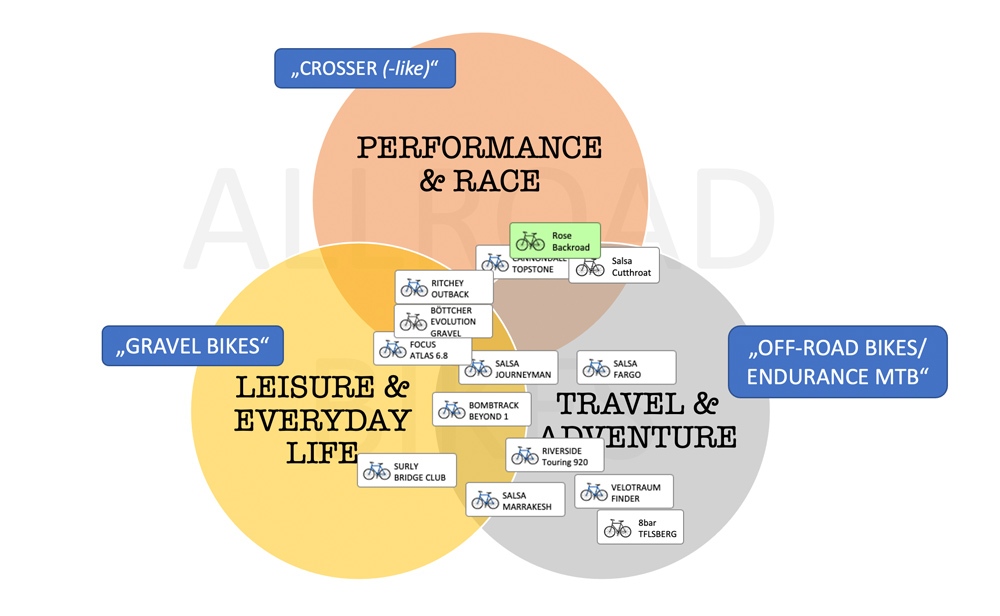
The Rose Backroad Carbon is a very fast and agile bike. With the right tires, it can unfold even more potential in my view, or bring to the road or gravel. The Backroad Carbon is an interesting gravel bike for road cyclists who can get a taste of gravel without having to give up the road bike feeling. For mountain bikers, it is an interesting candidate when it needs a faster bike that does not immediately fail off-road.
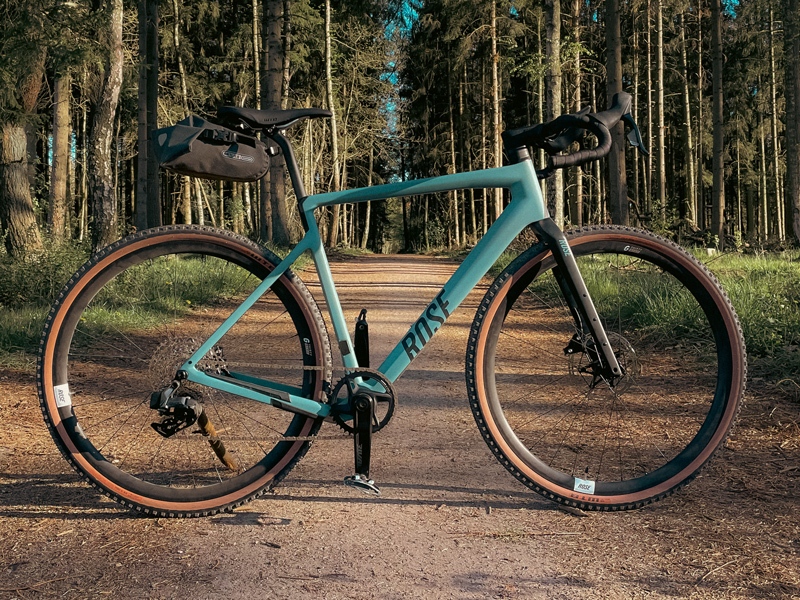
Should I ever buy a gravel bike, the Backroad would definitely be on my priority list. I have driven the wheel a total of over 500km, including 280km at a stretch and have driven it very much over gravel and forest soil. It has done all this very well and I have felt quite quickly very comfortable on the bike.
The Backroad Carbon is also suitable for Bikepacking of course. Only the system weight of 110kg limits here somewhat the bicycle wanderlust. In any case, you can go with the Rose Backroad Carbon to explore some Orbits and set up record times if necessary.

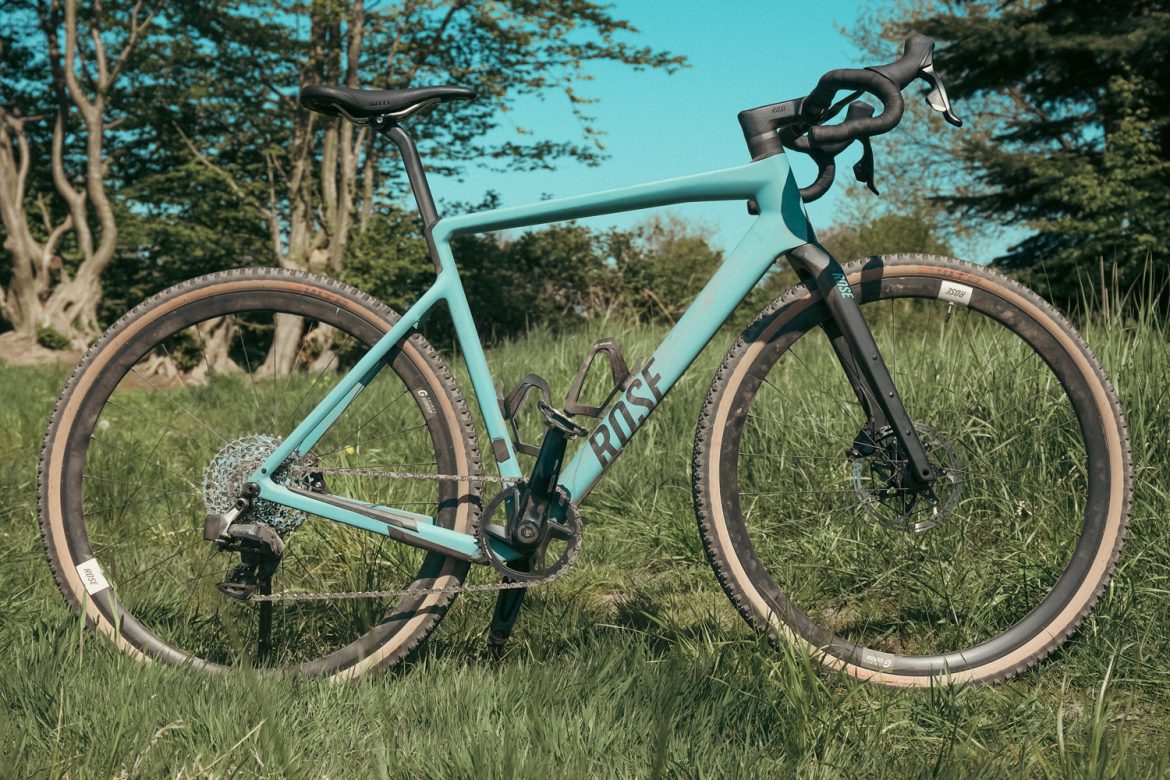
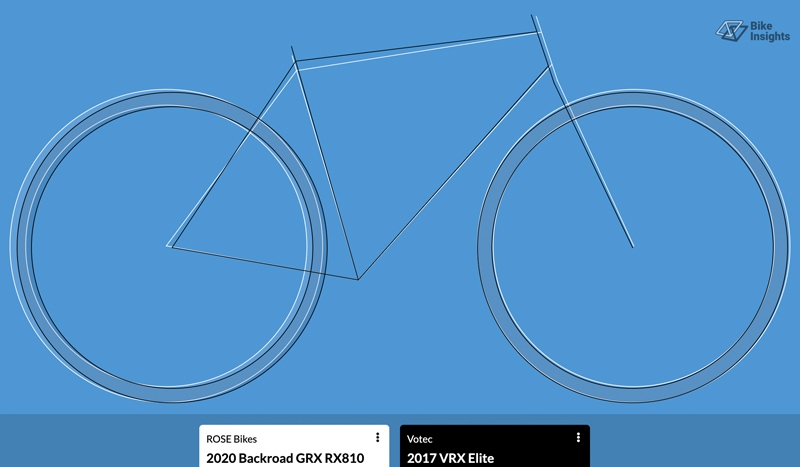
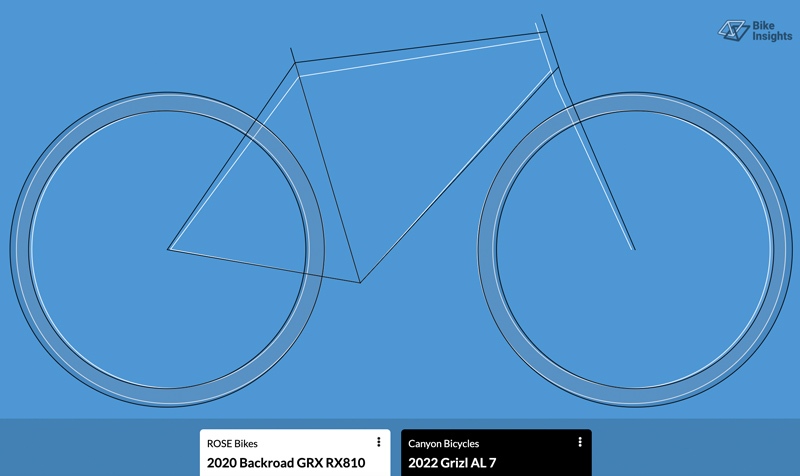
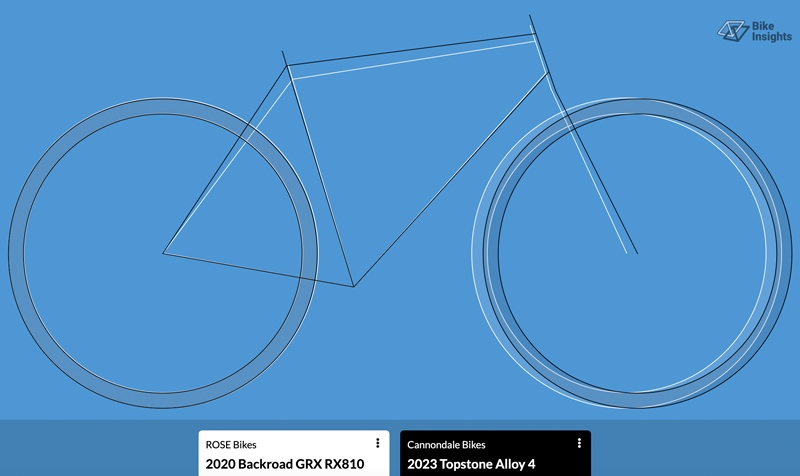
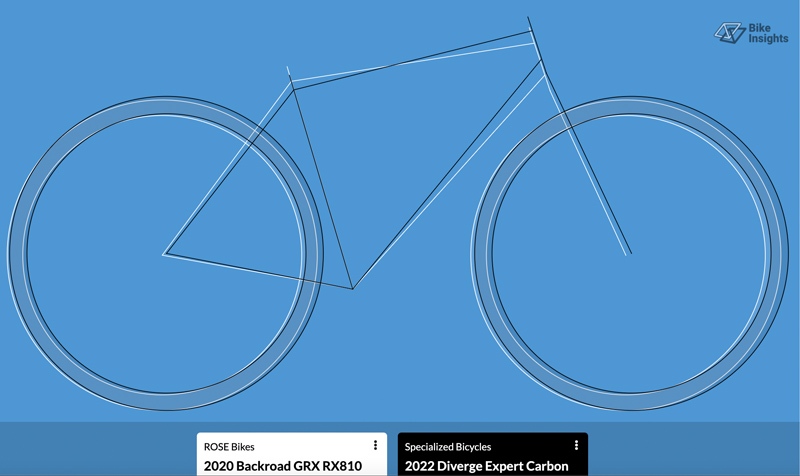
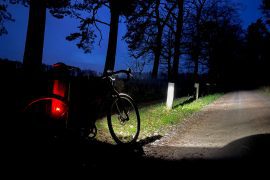
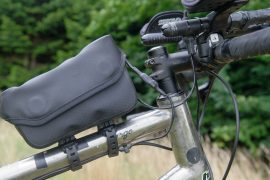
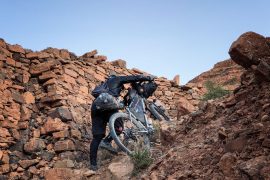
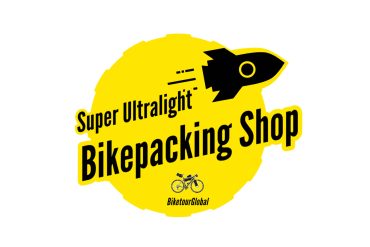
What’s the name of your top tube bag? 🙂